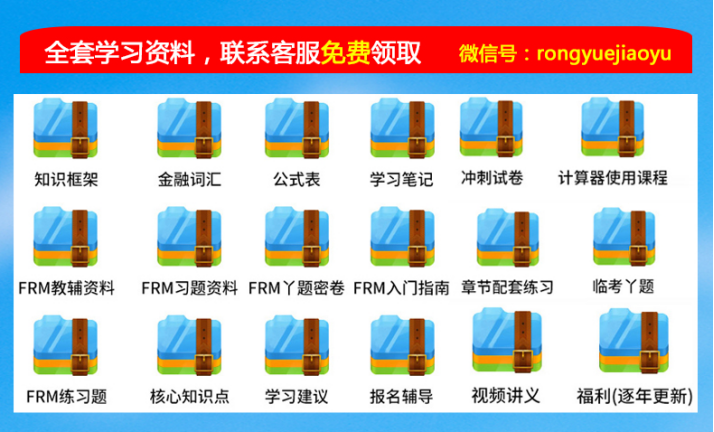2021年FRM考纲已经公布,下面就是融跃FRM研究院老师对zui新考纲的解读,各位同学请收下。
>>>点击领取2021年FRM备考资料大礼包(戳我免·费领取)
(注:红色内容为新增,蓝色内容为删除,绿色内容为修改,紫色内容为整合。)
FRM一级
风险管理基础(20%)
考纲解读:
该科目考试占比不变,有些章节描述有所改变,但其实值内容不变,新增和删除基本持平,部分章节内容有所整合,整体内容基本不变,备考同学按照按部就班复习即可。
Chapter 1. The Building Blocks of Risk Management
Describe challenges that can arise in the riskmanagement process(删除)
Chapter 2. How Do Firms Manage Financial Risk?
无变化
Chapter 3. The Governance of Risk Management
Explain changes in regulations(新增) and corporate risk governancethat occurred as a result of the 2007-2009 financial crisis.
Describe best practices for the governance of a firm’srisk management processes.(改为:把compare and contrast改为describe)
Assess the risk management role andresponsibilities of a firm’s board of directors.(改为:Assess改为explain)
Chapter 4. Credit Risk Transfer Mechanisms
explain how each one transfers credit risk anddescribe their advantages and disadvantages(改为:Compare different typesof credit derivatives, explain their applications, anddescribe their advantages)
Chapter 5. Modern Portfolio Theory (MPT) and the Capital AssetPricing Model (CAPM)
Interpret and comparethe capital market line and the security market line.(改为:ieterppretthe CML)
Chapter 6. The Arbitrage Pricing Theory and Multifactor Modelsof Risk and Return
Describethe inputs (including factor betas) to a multifactor model and explain the challenges of using multifactormodels in hedging.(新增)
explainmodels that account for correlations between asset returns in a multi-assetportfolio(删除).
Chapter 7. Principles for Effective Data Aggregationand Risk Reporting
由原来的7条整合到现在的4条内容基本不变化
Chapter 8. Enterprise Risk Management and Future Trends
comparethebenefit and costs of ERM (删除)
describe important dimensions of an ERM programand relate ERM to strategic planning(删除)
Chapter9、Chapter10、Chapter11不变
数量分析(20%)
该科目考试占比不变,自从上一年有一定改动后,内容编排更加合理,今年考纲内容没有任何变化,不论是对一战还是而战考生而说是一个利好。
无变化
金融市场产品(30%)
整体解读:
该科目考试占比不变,新考纲中调整的多是描述性词语,删除的内容与新增内容基本持平,知识主体框架和重点内容基本不变。建议同学按部就班备考即可。
Chapter 1. Banks
无变化
Chapter 2. Insurance Companies and Pension Plans
Compare the varioustypes of life insurance policies(新增)
Chapter 3、Chapter 4、 Chapter 5、 Chapter 6不变
Chapter 7. Futures Markets
describe the ration for margin requirements and explain how theywork(删除)
Describe the over-the-countermarket transactions(删除).
Explain (identify改成explain)the differences between a normal and invertedfutures market.explain the different market quotes(删除)
Chapter 8. Using Futures forHedging
Calculate the profit andloss on a short or long hedge(新增)
Chapter 9、Chapter 10、Chapter 11不变
Chapter 12. Options Markets
Describe the varioustypes, uses(新增), and typicalunderlying assets of options
Explain the payoff function(新增) and calculate theprofit and loss from an options position.
Describe theapplication of commissions, margin requirements(改为:原来是describe how trading,commissions,margin requirements), and exercise procedures to exchange-tradedoptions and explain the trading characteristics of these options(新增).
Chapter 13、Chapter14、Chapter 15、Chapter 16不变
Chapter 17. Corporate Bonds
Define recovery rateand default rate, and differentiate between an issue default rate and a dollardefault rate(删除:describe the relationshipbetween recovery rates and seniority)
Chapter 18、Chapter19、Chapter 20不变
估值模型(30%)
整体解读:
该科目考试占比不变,整体内容有所调整,删除内容集中在市场风险部分,压力测试部分也有删减和修改,非平行利率期限结构部分有新增和修改,一战考生按部就班复习即可,二战考生可重点关注相应内容变化,总体而言变化不大。
Chapter 1. Measures of Financial Risk
Describe spectral risk measures and explain how VaR and ES arespecial cases of spectral risk measures(删除)
Chapter 2. Calculating andApplying VaR
explain the full revalution method forcomputing VaR(删除)
Explainthe structured Monte Carlo method (删除stresstesting methods)forcomputing VaR and identify its strengths and weaknesses.
Chapter 3. Measuring and Monitoring Volatility
Evaluate the various approaches for estimating VaR(删除).
Chapter 4. External and Internal Credit Ratings
Explainthe potential impact of ratings changes on bond and stock prices.(改为:Describe the relationships between changes incredit ratings and changes in stock prices, bond prices, and credit defaultswap spreads.)
Chapter 5、Chapter6、Chapter 7不变
Chapter 8. Stress Testing
Explainkey considerations and challenges related to stress testing, including choiceof scenarios, regulatory specifications, model building, and reverse stresstesting.(改为:原来是Identify key aspects ofstress testing governance, including choice of scenarios, regulatoryspecifications,model building, stress-testing coverage, capital and liquiditystress testing and reverse stress testing.)
Describestressed VaR and stressed ES and compare the process of determining stressedVaR and ES to that of traditional VaR and ES.(改为:Explain the importance of stressed inputs andtheir importance in stressed VaR and stressed ES.)
Describethe key elements of effective governance over stress testing(删除).
Describethe important role of the internal audit in stress testing governance andcontrol(删除).
Chapter 9不变
Chapter 10. Interest Rates
Define spot rate and compute discount factorsgiven spot rates .(改为:原来是Definespot rate and compute spot rates given discount factors)
Chapter 11、Chapter12不变
Chapter13. Modeling Non-Parallel Term StructureShifts and Hedging
Describeand assess the major weakness attributable to single-factor approaches whenhedging portfolios or implementing asset liability techniques(新增).
Describethe key rate exposure technique in multi-factor hedging applications; summarizeits advantages•and disadvantages(新增)
Computethe positions in hedging instruments necessary to hedge the key rate risks of aportfolio.(改为:Calculate the key rateexposures for a given security and compute the appropriate hedging positionsgiven a specific key rate exposure profile.)
Chapter 14、Chapter15、Chapter 16不变
FRM二级
市场风险(20%)
考纲解读:
该科目考试占比不变,Market Risk的考纲几乎没有变化,考生安心备考即可。
信用风险(20%)
考纲解读:
该科目考试占比不变,章节顺序及标题有的发生变动,但内容不变,部分章节内容有变动和增加,主要集中在Credit Value Adjustments章节,考生重点关注即可,同时删掉了不太重要的的章节,整体架构不变。
Chapter:Credit Value Adjustments(新增)
Describe the variousregulatory capital requirements
Credit Exposure and funding(新增)
Describe thedifferences between funding exposure and credit exposure(新增)
Explain the impact of incorporating collateralizationinto the CVA calculation, including the impact of margin period of risk,thresholds, and initial margins(新增)
Calculate DVA,BCVA,and BCVA as a spread(新增)
Identify examples of wrong-way collateral(新增)
Describe the various wrong-way modeling methods includinghazard rate approaches, structural approaches, parametric approaches, and jumpapproaches(新增).
Explain the implications of central clearing on wrong-wayrisk(新增).
Describe covered bonds, fundingCLOs, and other securitization instruments for funding purposes(新增)
Chapter:CounterpartyRisk Intermediation(删除)
Operational Risk and Resiliency(20%)
考纲解读:
该科目考试占比不变,该部分内容在去年大改之后今年考试内容几乎没有任何变化,只是新增了一个小的知识点,建议同学按部就班备考即可。
Chapter:Regulation of the OTC Derivatives Market:
Calculate credit risk capital underBasel II utilizing the IRB approach(新增).
流动性风险(15%)
考纲解读:
该科目考试占比不变,由于是去年新增章节,今年考试内容几乎没有变化。
投资组合风险管理(15%)
该科目考试占比不变,相比去年今年该部分考试内容改动较多,但大多都是表述方式的改动,并无实质性变化,大体框架并无改变,建议同学不*于担心,二战考生需要关注其微小变动。
注:以下均为改动
Chapter:Factor Theory
Describe the capital asset pricing model (CAPM)(修改:Describe改成Discuss)
Chapter:Alpha (and the Low-RiskAnomaly)
Explain how to measure time-varying factor exposures andtheir use in style analysis.(改成:Explain how to use styleanalysis to handle time-varying factor exposures.)
Chapter:Portfolio Construction
Describe neutralization and methods for refining alphas to be neutral.(改成:Describe neutralization and thedifferent approaches used for refining alphas to be neutral.)
Assess the impact ofpractical issues in portfolio construction, such as determination of riskaversion, incorporation of specific risk aversion and proper alphacoverage(改成:Describe practical issues inportfolio construction, including the determination of an appropriate riskaversion, aversions to specific risks, and proper alpha coverage.)
Chapter:Portfolio Risk: AnalyticalMethods
Define, calculateand distinguish between the following portfolio VaR measures: individualVaR,incremental VaR, marginal VaR, component VaR, undiversified portfolio VaRand diversified portfolio VaR(改为:Define, calculate anddistinguish between the following portfolio VaR measures: diversified andundiversified portfolio VaR, individual VaR, incremental VaR, marginal VaR, andcomponent VaR).
Describe the challenges associated with VaR measurementas portfolio size increases(删除)
Chapter:VaR and Risk Budgeting in Investment Management
Apply VaR to check compliance, monitor risk budgets andreverse engineer sources of risk(改为:Explain the use of VaR to checkmanager compliance and monitor risk).
reverseengineer sources of risk(删除)
Explain how VaR can be used in the investment process andthe development of investment guidelines(改为:Explain how VaR canbe used in the development of investment guidelines and for improving theinvestment process.)
Chapter:Risk Monitoring and Performance Measurement
Define, compare andcontrast VaR and tracking error as risk measures(改为:Describe the three fundamentaldimensions behind risk management and their relation to VaR and tracking error.)
Chapter:Portfolio Performance Evaluation
Describe and distinguish between risk-adjustedperformance measures, such as Sharpe’s measure, Treynor’s measure, Jensen’s measure (Jensen’s alpha) and information ratio(改为:Describe risk-adjustedperformance measures, such as Sharpe’s measure, Treynor’s measure, Jensen’s measure (Jensen’s alpha) and the information ratio, and identify thecircumstances under which the use of each measure is most relevant.增加了适用场景).
Explain the difficulties in measuring the performance ofhedge funds(改为:Explain the difficulties inmeasuring the performance of actively managed portfolios.强调了activelymanaged portfolios)
Explain how changes in portfolio risk levels can affectthe use of the Sharpe ratio to measure performance(改为:Describe performancemanipulation and the problems associated with using conventional performancemeasures.突出了业绩操控和潜在问题).
Chapter:Hedge Funds
Evaluate the role ofinvestors in shaping the hedge fund industry(删除).
Chapter:Stephen G. Dimmockand William C. Gerken: Finding Bernie Madoff: Detecting Fraud by InvestmentManagers (2011) [IM–11]
Explain the use and efficacyof information disclosures made by investment advisors in predicting fraud(新增).
Describe the barriers and thecosts incurred in implementing fraud prediction methods(新增).
Discuss ways to improveinvestors’ ability to use disclosed data to predict fraud( 新增).
Current Issues(10%)
考纲解读:
该科目考试占比不变,今年考纲相比删除7篇文章,新加入7篇文章,总数10篇不变,去年增加了7篇文章,其中有4篇与新冠有关,重点在于新冠对金融市场的影响及相应的解决方案,建议同学在学习过程中与时俱进。
附:新加入7篇文章
1.Climate Change:Physical Risk and Equity, Global Financial Stability Report: Markets in theTime of COVID-19, International Monetary Fund (IMF), May 2020.
这篇文章讲解了zui新的气候变化如何影响金融稳定性。本章还详细讲解了气候变化如何影响股票价格和股票估值。并讨论了不同国家的特征对气候变化与股票价格之间关系的影响程度。
2.The Green Swan – CentralBanking and Financial Stability in the Age of Climate Change
这篇文章仍然讨论气候变化,讲解了Green Swan的概念,以及与Black Swan的区别。讨论了为何气候变化会是资产价格稳定性和金融稳定性的威胁。
3.When Selling BecomesViral: Disruptions in Debt Markets in the COVID-19 Crisis and the Fed’s Response
这篇文章讲解了在新冠疫情影响下,债券市场的发展以及美联储的应对。文章对比了债券市场在2008年金融危机和2019年新冠疫情下的发展。解释了2020年3月至4月之间债券市场价格波动的影响,并解释了美联储在此之间的干预措施。
4.Global Financial Stability Report: Markets in theTime of COVID-19, International Monetary Fund (IMF), May 2020.
这篇文章主要描述了金融市场和大宗商品市场在2020年3月至4月之间的情况,探讨了应对新冠疫情的各种货币和金融政策。
5.Financial Crime inTimes of COVID-19 –AML and Cyber Resilience Measures”, Financial StabilityInstitute, May 2020
这篇文章讨论了反洗钱和网络安全应变措施。详细讨论了由于新冠疫情带来的网络安全的威胁。解释了全球的和各国应对网络安全威胁的措施。
6.Stephen Cecchetti,Kim Schoenholtz, “ReplacingLIBOR” https://voxeu.org/article/replacing-libor.September 2019.
这篇文章解释了当LIBOR体系结束可能带来的影响,介绍了目前的过渡成果和未来面临的挑战。并讨论了政府在过渡过程中的作用。
7.Cyber Risk and theU.S. Financial System: A Pre-Mortem Analysis
这篇文章探讨了网络攻击的直接成本和影响,以及网络攻击如何通过金融网络放大。并讨论了一些可以应对网络安全的应对措施。
总而言之,经历去年大变动之后,今年一二级考纲变动不大,大部分内容只是表述方式的变化,删除和新增内容基本持平,准备明年考试的同学可以安心备考了。
从去年新考纲大修之后,考纲逻辑架构更加合理,今年内容更加与时俱进,看着GARP协会越来越走上正轨,小编心理也是乐开了花,明年的考生就偷着乐吧。
- 报考条件
- 报名时间
- 报名费用
- 考试科目
- 考试时间
-
GARP对于FRM报考条件的规定:
What qualifications do I need to register for the FRM Program?
There are no educational or professional prerequisites needed toregister.
翻译为:报名FRM考试没有任何学历或专业的先决条件。
可以理解为,报名FRM考试没有任何的学历和专业的要求,只要是你想考,都可以报名的。查看完整内容 -
2024年5月FRM考试报名时间为:
早鸟价报名阶段:2023年12月1日-2024年1月31日。
标准价报名阶段:2024年2月1日-2024年3月31日。2024年8月FRM考试报名时间为:
早鸟价报名阶段:2024年3月1日-2024年4月30日。
标准价报名阶段:2024年5月1日-2024年6月30日。2024年11月FRM考试报名时间为:
早鸟价报名时间:2024年5月1日-2024年7月31日。
标准价报名时间:2024年8月1日-2024年9月30日。查看完整内容 -
2023年GARP协会对FRM的各级考试报名的费用作出了修改:将原先早报阶段考试费从$550上涨至$600,标准阶段考试费从$750上涨至$800。费用分为:
注册费:$ 400 USD;
考试费:$ 600 USD(第一阶段)or $ 800 USD(第二阶段);
场地费:$ 40 USD(大陆考生每次参加FRM考试都需缴纳场地费);
数据费:$ 10 USD(只收取一次);
首次注册的考生费用为(注册费 + 考试费 + 场地费 + 数据费)= $1050 or $1250 USD。
非首次注册的考生费用为(考试费 + 场地费) = $640 or $840 USD。查看完整内容 -
FRM考试共两级,FRM一级四门科目,FRM二级六门科目;具体科目及占比如下:
FRM一级(共四门科目)
1、Foundations of Risk Management风险管理基础(大约占20%)
2、Quantitative Analysis数量分析(大约占20%)
3、Valuation and Risk Models估值与风险建模(大约占30%)
4、Financial Markets and Products金融市场与金融产品(大约占30%)
FRM二级(共六门科目)
1、Market Risk Measurement and Management市场风险管理与测量(大约占20%)
2、Credit Risk Measurement and Management信用风险管理与测量(大约占20%)
3、Operational and Integrated Risk Management操作及综合风险管理(大约占20%)
4、Liquidity and Treasury Risk Measurement and Management 流动性风险管理(大约占15%)
5、Risk Management and Investment Management投资风险管理(大约占15%)
6、Current Issues in Financial Markets金融市场前沿话题(大约占10%)查看完整内容 -
2024年FRM考试时间安排如下:
FRM一级考试:
2024年5月4日-5月17日;
2024年8月3日(周六)上午;
2024年11月2日-11月15日。FRM二级考试:
2024年5月18日-5月24日;
2024年8月3月(周六)下午;
2024年11月16日-11月22日。查看完整内容
-
中文名
金融风险管理师
-
持证人数
25000(中国)
-
外文名
FRM(Financial Risk Manager)
-
考试等级
FRM考试共分为两级考试
-
考试时间
5月、8月、11月
-
报名时间
5月考试(12月1日-3月31日)
8月考试(3月1日-6月30日)
11月考试(5月1日-9月30日)









